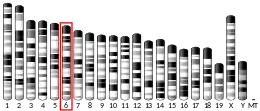| TRA2A | |||||||||||||||||||||||||||||||||||||||||||||||||||
|---|---|---|---|---|---|---|---|---|---|---|---|---|---|---|---|---|---|---|---|---|---|---|---|---|---|---|---|---|---|---|---|---|---|---|---|---|---|---|---|---|---|---|---|---|---|---|---|---|---|---|---|
| Identifiers | |||||||||||||||||||||||||||||||||||||||||||||||||||
| Aliases | TRA2A, AWMS1, HSU53209, transformer 2 alpha homolog | ||||||||||||||||||||||||||||||||||||||||||||||||||
| External IDs | OMIM: 602718 MGI: 1933972 HomoloGene: 40866 GeneCards: TRA2A | ||||||||||||||||||||||||||||||||||||||||||||||||||
| |||||||||||||||||||||||||||||||||||||||||||||||||||
| |||||||||||||||||||||||||||||||||||||||||||||||||||
| |||||||||||||||||||||||||||||||||||||||||||||||||||
| |||||||||||||||||||||||||||||||||||||||||||||||||||
| |||||||||||||||||||||||||||||||||||||||||||||||||||
| Wikidata | |||||||||||||||||||||||||||||||||||||||||||||||||||
| |||||||||||||||||||||||||||||||||||||||||||||||||||
Transformer-2 protein homolog alpha is a protein that in humans is encoded by the TRA2A gene.[5][6][7]
This gene is a member of the transformer 2 homolog family and encodes a protein with two RS domains and an RRM (RNA recognition motif) domain. This phosphorylated nuclear protein binds to specific RNA sequences and plays a role in the regulation of pre-mRNA splicing. Several alternatively spliced transcript variants of this gene have been described; however, the full-length nature of some of these variants has not been determined.[7]
References
- 1 2 3 GRCh38: Ensembl release 89: ENSG00000164548 - Ensembl, May 2017
- 1 2 3 GRCm38: Ensembl release 89: ENSMUSG00000029817 - Ensembl, May 2017
- ↑ "Human PubMed Reference:". National Center for Biotechnology Information, U.S. National Library of Medicine.
- ↑ "Mouse PubMed Reference:". National Center for Biotechnology Information, U.S. National Library of Medicine.
- ↑ Dauwalder B, Amaya-Manzanares F, Mattox W (Oct 1996). "A human homologue of the Drosophila sex determination factor transformer-2 has conserved splicing regulatory functions". Proc Natl Acad Sci U S A. 93 (17): 9004–9. Bibcode:1996PNAS...93.9004D. doi:10.1073/pnas.93.17.9004. PMC 38585. PMID 8799144.
- ↑ Tacke R, Tohyama M, Ogawa S, Manley JL (May 1998). "Human Tra2 proteins are sequence-specific activators of pre-mRNA splicing". Cell. 93 (1): 139–48. doi:10.1016/S0092-8674(00)81153-8. PMID 9546399. S2CID 15384749.
- 1 2 "Entrez Gene: TRA2A transformer-2 alpha".
Further reading
- Sanger Centre T, Washington University Genome Sequencing Cente T (1999). "Toward a complete human genome sequence". Genome Res. 8 (11): 1097–108. doi:10.1101/gr.8.11.1097. PMID 9847074.
- Strausberg RL, Feingold EA, Grouse LH, et al. (2003). "Generation and initial analysis of more than 15,000 full-length human and mouse cDNA sequences". Proc. Natl. Acad. Sci. U.S.A. 99 (26): 16899–903. Bibcode:2002PNAS...9916899M. doi:10.1073/pnas.242603899. PMC 139241. PMID 12477932.
- Matsuda A, Suzuki Y, Honda G, et al. (2003). "Large-scale identification and characterization of human genes that activate NF-kappaB and MAPK signaling pathways". Oncogene. 22 (21): 3307–18. doi:10.1038/sj.onc.1206406. PMID 12761501.
- Shin C, Feng Y, Manley JL (2004). "Dephosphorylated SRp38 acts as a splicing repressor in response to heat shock". Nature. 427 (6974): 553–8. Bibcode:2004Natur.427..553S. doi:10.1038/nature02288. PMID 14765198. S2CID 4423246.
- Jin J, Smith FD, Stark C, et al. (2004). "Proteomic, functional, and domain-based analysis of in vivo 14-3-3 binding proteins involved in cytoskeletal regulation and cellular organization". Curr. Biol. 14 (16): 1436–50. doi:10.1016/j.cub.2004.07.051. PMID 15324660. S2CID 2371325.
- Gerhard DS, Wagner L, Feingold EA, et al. (2004). "The status, quality, and expansion of the NIH full-length cDNA project: the Mammalian Gene Collection (MGC)". Genome Res. 14 (10B): 2121–7. doi:10.1101/gr.2596504. PMC 528928. PMID 15489334.
- Gevaert K, Staes A, Van Damme J, et al. (2006). "Global phosphoproteome analysis on human HepG2 hepatocytes using reversed-phase diagonal LC". Proteomics. 5 (14): 3589–99. doi:10.1002/pmic.200401217. PMID 16097034. S2CID 895879.
- Rual JF, Venkatesan K, Hao T, et al. (2005). "Towards a proteome-scale map of the human protein-protein interaction network". Nature. 437 (7062): 1173–8. Bibcode:2005Natur.437.1173R. doi:10.1038/nature04209. PMID 16189514. S2CID 4427026.
- Beausoleil SA, Villén J, Gerber SA, et al. (2006). "A probability-based approach for high-throughput protein phosphorylation analysis and site localization". Nat. Biotechnol. 24 (10): 1285–92. doi:10.1038/nbt1240. PMID 16964243. S2CID 14294292.
- Olsen JV, Blagoev B, Gnad F, et al. (2006). "Global, in vivo, and site-specific phosphorylation dynamics in signaling networks". Cell. 127 (3): 635–48. doi:10.1016/j.cell.2006.09.026. PMID 17081983. S2CID 7827573.
This article is issued from Wikipedia. The text is licensed under Creative Commons - Attribution - Sharealike. Additional terms may apply for the media files.




